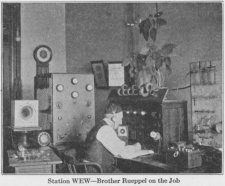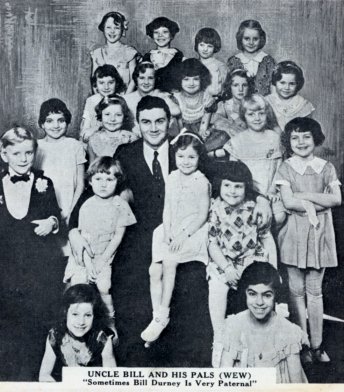Radio Articles
There Were Several “Firsts” At WEW
In radio’s earliest days, there was a lot of excitement on the campus of St. Louis University. The school, it seems, was a pioneer in the medium’s development, long before anyone heard voices coming from their radios.
As early as 1912, the university was trying something new in wireless transmissions. Their station, 9YK, was being used to stay in contact with earthquake and seismological stations around the U.S. The university’s observatory would also transmit weather reports over 9YK, but all these broadcasts were in Morse Code, using a broadcast technology perfected by Marconi some 10 years earlier.
This sort of use of radio waves did not escape the attention of the government, but U.S. entry into World War I brought technological development to a screeching halt. All wireless stations, including the St. Louis University station, were shut down so the nation’s brainpower could be devoted to winning the war. But things on the campus changed quickly.
It seems the government realized the value of wireless in war communications, and it sent 380 young military men to the campus to what was quickly dubbed the Radio and Buzzer School. Run by the War Department, the school trained men for duty as telegraphers in the Army and Navy. There were courses in International Morse Code and the fundamentals of electricity.
Station 9YK was back on the air in 1919, being used by the government to relay weather information and livestock and grain reports across the nation. All records indicate this was still being done in Morse Code, although voice and music transmission had been accomplished elsewhere as early as 1906 by Reginald Fessenden.

Voice and music first came to the St. Louis airwaves over 9YK at 10:05 a.m. April 26, 1921, when the station was under the oversight of Brother George Rueppel, S.J., who was head of the university’s meteorology department. The first voice heard of WEW was that of University President, the Rev. William Robison, S.J. Regular radio service soon began, with stock market, grain market and weather reports broadcast each day.
On March 23, 1922 the station was licensed by the government and given the call letters WEW, which Bro. Rueppel would later claim stood for “We Enlighten the World.” In the interest of factual trivia, it should be noted that another station in St. Louis had been licensed earlier. The Post-Dispatch station KSD had received its license a couple weeks before, on March 8.
Credited with being the “father” of WEW, Bro. Rueppel can also lay claim to another first here: On July 16, 1921, he brought a gramophone into the campus studio, put on a record and held the station’s microphone up to the horn of the gramophone, thus becoming St. Louis’ first disc jockey. He also hosted a daily show popular with the ladies. “Aunt Sammy’s Prize Recipes,” in which he came across as a cooking expert.
WEW lays claim to being the first university radio station in the U.S., the first station west of the Mississippi, and the first radio broadcast of a quiz show, the “Question Box Hour,” in 1923.
(Reprinted with permission of the St. Louis Journalism Review. Originally published 4/2006)
